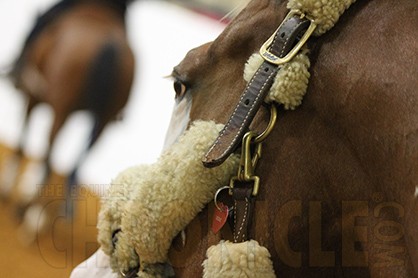Safe Supplements For EMS/IR and Cushing’s Horses
By: Eleanor M. Kellon, VMD
The cornerstone of managing horses and ponies with metabolic issues resulting in high insulin, is tight control of their diet — specifically, avoiding anything that would promote higher insulin.
Easy weight gain, lumpy fat deposits, puffy fat above the eye, and a fatty crest on the neck are among the signs of high insulin.
Most questions I get concern the safety of the inactive or carrier ingredients in a supplement. Things like alfalfa, yeast, brewer’s or distiller’s dried grains, inulin, maltodextrin, seed meals, and brans are often found in supplements, while “balancers” can also include grain products. The two factors to consider are (1) the composition of those ingredients; and (2) how you are feeding them.
Things safe in any amount include plain beet pulp (but not citrus pulp), brewer’s/distiller’s dried grains, and hulls/seed coats. Inulin is an easily fermented fructan that can cause hind gut laminitis but it takes multiple pounds to have any effect, so amounts in supplements are not a concern. Flaxseed meal is safe. Other seed meals, like sunflower, are also usually safe but may be pushing the envelope at 10 to 11% sugar and starch.
Alfalfa is in a special category because although the sugar and starch level is usually safe, some horses do not tolerate it well. There is some evidence in horses (and a lot more in humans) that high protein intakes and specific amino acids may trigger an insulin response.
Ingredients to watch include:
Maltodextrin/dextrose/glucose – 100% sugar
Dried Molasses – 35 to 50% sugar (average to high)
Grains – 40 to 60% starch
Wheat and Rice Bran – 27/28 to 36/42% sugar + starch
Dry yeast – 17 to 39% sugar + starch
Soybean meal – 11 to 27% sugar + starch
To put things in perspective, a pound of 6% sugar and 2% starch safe hay would yield about 36 g. of sugar, which is 1.3 oz. However, some of that sugar would be fructose, which does not give a significant insulin response, so a corrected value would be 28 g. of sugar. This would be the equivalent of 1 oz of maltodextrin or 2+ oz of molasses, although we can’t really say the resultant insulin rise from 1 lb of that hay would be same as 2 oz of straight dried molasses!
Once you have identified potentially problematic ingredients, the next step is to determine how much of it is in the supplement – which sometimes is almost impossible. If you have an electrolyte supplement that is 25% electrolytes in a pure maltodextrin base, and you feed 2 oz of it, 75% of that, or 1.5 oz, is straight sugar. More often though you have many ingredients in the carrier.
First step is to add up the amounts of active ingredients in a serving and subtract that from the serving size. This gives you the amount of base. Since you won’t know how much of each base ingredient is in there, you could create a worst case scenario and assume that high sugar and starch ingredients make up most of the base. This may determine whether or not you feel comfortable feeding the supplement “as is” but that’s not the usual way they are fed.
Most supplements are fed with a carrier, either beet pulp, hay cubes/pellets, or a low sugar/starch feed. What you need to do then is to average the sugar and starch of the supplement with the meal. For example, let’s use 2 oz of a 15% sugar and starch supplement, fed in 14 oz of 6% sugar beet pulp. The supplement contributes 2/16 x 15% and the beet pulp 14/16 x 6% = 7.125% sugar and starch total in the meal. If you added 2 oz of that 85% sugar electrolyte to 14 oz of 6% beet pulp you would end up with a 15.8% sugar + starch meal. If your 2 oz of supplement was 85% base with 50% sugar and starch your end result would be 9.8% sugar + starch.
The bottom line here is that supplements with questionably safe base ingredients may still be safe depending on how much is in there, how much you feed, and the type and amount of carrier you use. Avoid the super high base ingredients like maltodextrin/dextrose/glucose or molasses but otherwise you may be fine when using supplements as part of a meal.
If you get bogged down in the math – reach out. I’ll be glad to help. If you shop Uckele, they have taken out all the guesswork with a section devoted to Cushing’s and Metabolic Syndrome safe products https://uckele.com/horse/ecir-friendly-products.html.
About ECIR Group Inc.
Started in 1999, the ECIR Group is the largest field-trial database for PPID and EMS in the world and provides the latest research, diagnosis, and treatment information, in addition to dietary recommendations for horses with these conditions. Even universities do not and cannot compile and follow long term as many in-depth case histories of PPID/EMS horses as the ECIR Group.
In 2013 the Equine Cushing’s and Insulin Resistance Group Inc., an Arizona nonprofit corporation, was approved as a 501(c)3 public charity. Tax deductible contributions and grants support ongoing research, education, and awareness of Equine Cushing’s Disease/PPID and EMS.
THE MISSION of the ECIR Group Inc. is to improve the welfare of equines with metabolic disorders via a unique interface between basic research and real-life clinical experience. Prevention of laminitis is the ultimate goal. The ECIR Group serves the scientific community, practicing clinicians, and owners by focusing on investigations most likely to quickly, immediately, and significantly benefit the welfare of the horse.











